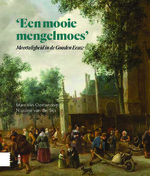‘Een mooie mengelmoes’
Meertaligheid in de Gouden Eeuw
Author(s)
van Oostendorp , Marc
van der Sijs, Nicoline
Language
Dutch; FlemishAbstract
The linguistic relality in the Netherlands during the Golden Age was in fact one of multilingualism: so many languages and dialects were used. Nicoline van der Sijs and Marc van Oostendorp show how the emergence of the Dutch language can only be understood against this multilinguistic background. Taal was belangrijk in de Gouden Eeuw. Schrijvers, dichters, taalgeleerden en journalisten legden zelfbewust de basis voor wat het Standaardnederlands zou worden, een taal waarop iedereen even trots leek te zijn als op de nieuwe Republiek. Tegelijkertijd openden de Lage Landen zich voor de rest van de wereld, onder andere door de handel en het vroege kolonialisme, maar ook door belangstelling voor de ‘nieuwe’ kunsten uit Italië en Frankrijk. Bovendien kwamen door de grote welvaart heel veel migranten uit binnen- en buitenland naar Amsterdam.
In ‘Een mooie mengelmoes’ laten Nicoline van der Sijs en Marc van Oostendorp zien dat het ontstaan van het Nederlands alleen kan worden begrepen tegen de achtergrond van al die talen en dialecten die er toen in de Lage Landen werden geschreven. De auteurs presenteren het eerste onderzoek naar de pas ontsloten schat van zeventiende-eeuwse kranten – Nederlandse drukkers zetten in dit eerste massamedium internationaal de toon – én ze laten zien hoe schrijvers buitenlandse modellen imiteerden. Maar dat deden in ‘zuiver’ Nederlands, en niet in een ‘mengelmoes’ van leenwoorden zoals die in het dagelijks leven werd gebruikt.
Keywords
Nederlands; geschiedenis van taal; Gouden eeuw; Dutch; language history, Golden Age; multilingualismOCN
1126187317Publisher
Amsterdam University PressPublisher website
https://www.aup.nl/Publication date and place
Amsterdam, 2019Classification
Linguistics
Literature: history and criticism


 Download
Download